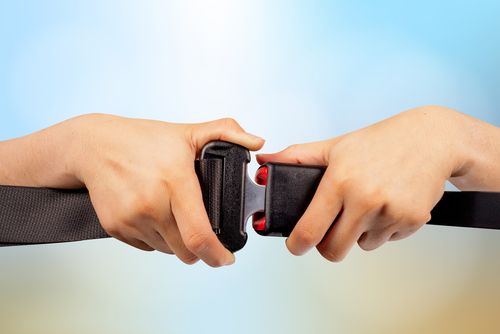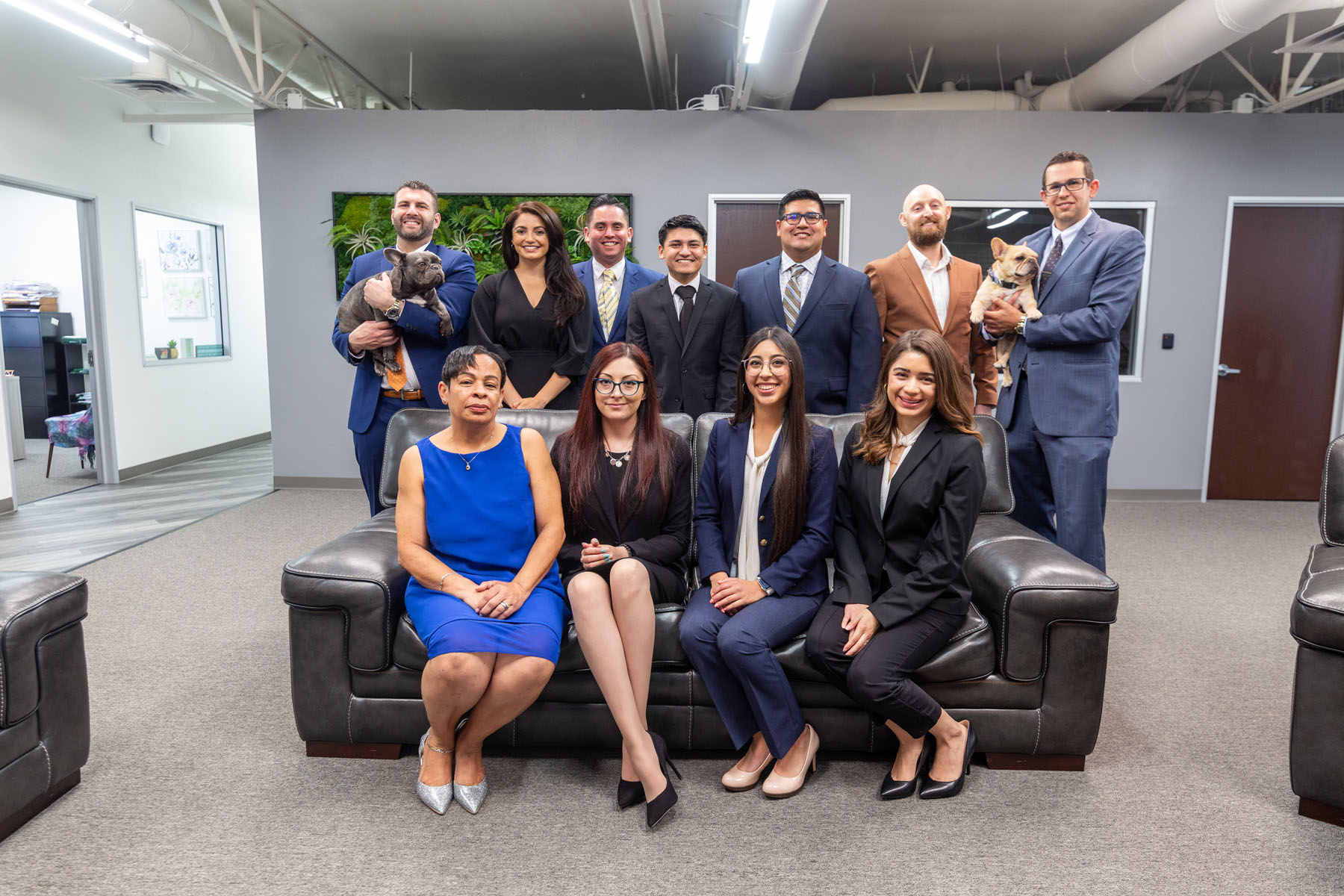No matter which state you live in, there’s a good chance the seat belt laws are a lot stricter than they used to be. Some older adults remember roaming freely in the backseat and climbing up into the rear window while going on family vacations. Today, there’s more traffic on the roads and a greater risk of getting injured in an accident. We also have research that proves wearing seatbelts saves lives.
Every year, the Centers for Disease Control and Prevention (CDC) collects data and presents statistics related to seat belt use. The CDC reports that seat belt use is on the rise. This is due in part to the implementation of seat belt laws. But education and improved technology have also contributed to the increase that has saved thousands of lives.

As of 2019, every state except New Hampshire has implemented some type of mandatory seat belt law. The laws differ from state-to-state in several ways including:
- Primary Vs Secondary Laws – In states where seat belt use is primary, police officers can stop and ticket you for not wearing a seat belt or other restraining device. In states where seat belt use is secondary, law enforcement must stop you for a different offense before writing you a ticket for not buckling up.
- Front Seat Vs Rear Seat Passengers – In some states, seat belts are only required in the front seat. In others, both the front and rear seat passengers must comply.
- Driver Liability Vs Passenger Liability – In some states, the driver is responsible for making all passengers in their vehicle buckle up. That means the driver can be ticketed and fined when anyone isn’t wearing the appropriate restraint for their age. It also means that driver could be liable for a passenger’s injuries, even if the accident isn’t entirely their fault.
- Age requirements for seat belt use.
- Additional fines for not wearing the seat belt correctly.
- The severity of the fines/punishment.
Knowing your state’s seat belt laws will prevent you from getting fined. It can even prevent you from being held liable when a passenger is injured during a car wreck. It isn’t enough to know your state’s laws. If you plan to drive in a different state, you need to know their laws too! The laws apply to all drivers in the state, not only those with a local license plate.
State-By-State Seat Belt Laws
Alabama – In 1999, the “Yellowhammer State” changed from a secondary to a primary seat belt law. The state requires front seat occupants to wear safety belts properly at all times when the vehicle is in motion. All children under the age of 5 must have the proper child passenger restraint system for their age and size. Children from 6 to 15 must always wear a seatbelt. Prior to 2006, the seat belt laws only covered passengers through the age of 3 years.
Alaska – In 2006, “The Last Frontier” state became the 23rd state to enact a primary seat belt law. All occupants of a vehicle are required to wear the appropriate restraints.
Arizona – All front-seat passengers are required to wear a properly fitted restraint while riding in “The Grand Canyon State.” Those under the age of 16 years must buckle up in the front or rear seats. Arizona’s seat belt laws only apply to vehicles manufactured in 1972 or newer while carrying no more than ten passengers. Arizona has a secondary seat belt law.
Arkansas– “The Natural State” has a primary seat belt law that requires children riding in the front or rear seats to buckle up. Kids must ride in an appropriate child restraint system until they reach the age of 6 years or 60 pounds.
California – California takes their seat belt laws seriously. “The Golden State” cites extensive evidence that seat belts save lives for their strong seat belt laws. Every adult over the age of 16 years must wear an approved seat belt. Occupants younger than 16 are required to use an appropriate car seat or booster seat. The law extends to the use of lower seat belts which cross the hips or upper thighs and the upper seat belt which they require occupants to wear across the front chest. In addition to holding passengers accountable for buckling up, the driver is also responsible for the actions of every passenger. The primary seat belt law allows officers to stop you and ticket you for failing to wear a seat belt or wearing it improperly.
Colorado – The driver and all passengers must wear a seat belt in “The Centennial State.” The secondary seat belt law only allows officers to ticket you after stopping you for a separate offense. On the other hand, Colorado’s seat belt laws allow officers to pull drivers over when a child passenger isn’t properly restrained. If you are ticketed for failing to properly restrain a child, not wearing a seat belt could become a secondary offense after the officer pulls you over.
Connecticut – “The Constitution State” considers seat belt violations as a secondary offense. All front seat passengers must wear a seat belt in addition to rear-seat passengers between the ages of 4 and 16 years. If you are cited for a secondary offense, you are responsible for any of your passengers that aren’t buckled up too!
Delaware – “The First State” has primary seat belt laws for drivers and passengers aged 16 years and older. The state boasts 92% seat belt use compared to the national use rate of 86%. Their no-nonsense approach to buckling up through their “Click It or Ticket” enforcement is setting an example for other states with less strict laws.
Florida – If you plan to drive in “The Sunshine State” in a car manufactured since 1968, everyone in the front seat must wear a seat belt. Those under the age of 18 years must use the appropriate seat belt or child restraint. Florida is a secondary seat belt state that doesn’t allow law enforcement to stop you for failing to wear a seat belt.
Georgia – “The Peach State” has a primary seat belt state law requiring drivers and passengers in the front seat aged 18 years and older to wear a seat belt. Passengers between the ages of 8 and 17 must wear a seat belt in any seat of the vehicle. Child restraint laws apply to any passenger under the age of 8 years old.
Hawaii– “The Aloha State” isn’t as welcoming to visitors who ignore their seat belt laws. Hawaii has primary seat belt laws that require the driver and all passengers to wear a seat belt. Drivers pay between $102 and $112 for violating the seat belt laws or take a four-hour safety class and pay $100 to $500 if they violate the child restraint laws.
Idaho – “The Gem State” has a secondary seat belt law which requires everyone in any vehicle to buckle up. Idaho holds drivers accountable for passengers under the age of 18 who are not appropriately restrained.
Illinois – Anyone aged 8 years and older must buckle up in “The Prairie State.” The laws extend to vehicles with airbags. Any passenger under the age of 8 years must be secured in an acceptable child restraint system. Illinois has a primary seat belt law that allows officers to stop and ticket you for seat belt offenses.
Indiana – The law requires anyone in the car to wear a seatbelt while going in forward motion in “The Hoosier State.” This primary seat belt state implements stricter laws on offenses involving the failure to use proper child restraints.
Iowa – Passengers under the age of 6 years must be secured in a proper safety seat or booster seat while riding in “The Hawkeye State.” Children aged from 6 to 11 years must either wear a safety belt or child restraint system. Those under the age of 18 years must wear a seat belt. Iowa is a primary seat belt state.
Kansas – Kansas is a primary seatbelt state with regards to stopping and ticketing drivers and front seat passengers under the age of 18 who aren’t wearing a seat belt. A secondary seat belt law applies to passengers in the back seat allowing law enforcement in “The Sunflower State” to write a ticket after you are already stopped.
Kentucky – “The Bluegrass State” has been resistant to updating seat belt laws, in spite of the best efforts of former Governor Steve Beshear. Today, all passengers who aren’t covered by laws mandating child restraints must wear seat belts. Kentucky allows those with a physician’s letter citing medical conditions to forego the restraints. The state has a primary seat belt law and requires everyone wearing a seat belt to have it properly adjusted and fastened.
Louisiana – Louisiana requires drivers of vehicles with a gross weight of ten thousand pounds or less to wear a seat belt while in forward motion. “The Pelican State” applies their primary laws to vehicles manufactured on or after January 1, 1981. Some types of service vehicles are also excluded from the law.
Maine – As of September 2007, “The Pine Tree State” is a primary seat belt state. Maine requires drivers and passengers aged 18 and older to wear a seatbelt. Additional laws mandate the use of appropriate child-restraint systems for children in any vehicle.
Maryland – “The Old Line State” has a split law, applying primary laws to passengers under the age of 16. Those over the age of 16 in the front or rear seat are required to wear a seatbelt but not wearing one is treated as a secondary offense.
Massachusetts – When driving in “The Bay State”, all occupants of the car aged 13 years and older must wear seat belts. Those with a disability or medical condition that makes belt use difficult or impossible require proof from a physician to forego the law. Vehicles manufactured prior to July of 1966 and some types of emergency vehicles are exempt.
Michigan – Drivers in “The Great Lakes State” must abide by primary seat belt law. Michigan requires passengers between the ages of 8 and 15 years to buckle up regardless of where they ride. All drivers and front-seat passengers must wear a seatbelt.
Minnesota – “The North Star State” has primary seat belt laws mandating all passengers and drivers to buckle up. Children must also wear appropriate child restraints and all restraining devices must be worn correctly. Minnesota offers stiff penalties to the driver for a first offense, often exceeding $100.
Mississippi – “The Magnolia State” passed a new seat belt law in 2017, requiring everyone in all types of vehicles to wear seat belts. Mississippi also has primary seat belts laws for passengers aged 7 years and older, taller than 57 inches, or who weigh more than 65 pounds. The new law prohibits anyone from riding in the bed of a pickup truck.
Missouri– “The Show Me State” currently has secondary seat belt laws, but a bipartisan group of Missouri mayors has made getting a primary seat belt law a priority. The group, known as the “Missouri Mayors United for Progress,” wants to implement a bill that subjects failing to buckle up to fines, along with texting while driving. Currently, Missouri requires all drivers and front-seat passengers to wear seat belts. When the driver has an intermediate driver’s license, all occupants in the vehicle must buckle up.
Montana – Montana has a secondary seat belt law that applies to drivers and all other occupants in a vehicle. “The Treasure State” requires appropriate child restraints for children under 6 years of age or who weigh less than 60 pounds.
Nebraska – “The Cornhusker State” has a secondary seat belt law and requires drivers and front-seat passengers to buckle up. In vehicles with drivers having a provisional operator’s permit or school permit, all passengers must buckle up.
Nevada – Nevada is another state with secondary seat belt laws. “The Silver State” requires all occupants to wear seat belts or wear the proper restraining device according to their age. Vehicles manufactured in 1968 or newer must be equipped with lap belts. Those manufactured in 1970 or later must have both lap belts and shoulder belts in the front seats.
New Hampshire – As mentioned earlier, New Hampshire is the only state that doesn’t have a primary or secondary seat belt law which applies to adults. However, “The Granite State” does have a primary child passenger safety law mandating the use of seat belts or safety restraints for drivers and passengers under the age of 18 years.
New Jersey – In New Jersey, passengers in the front seat who don’t wear a seatbelt are subject to charges of a primary offense. “The Garden State” might charge those in the backseat with a secondary offense.
New Mexico – In “The Land of Enchantment”, anyone riding in a vehicle that was manufactured with seatbelts is required to buckle up while the vehicle is in motion. New Mexico has a primary seat belt law, which allows law enforcement to stop and ticket drivers for seat belt offenses.
New York – “The Empire State” has a primary seat belt law that requires all front seat passengers to buckle up. Children under the age of 16 who ride in the rear seat must buckle up. Children under the age of 4 years must use appropriate child safety seats.
North Carolina – The primary seat belt law in North Dakota mandates that all occupants aged 16 years and older must wear a seat belt. The seat belt laws in “The Tar Heel State” extend to all vehicles required by federal law to be equipped with seatbelts.
North Dakota – “The Peace Garden State” has a secondary seat belt law which requires all drivers and passengers in the front seat to wear a seat belt that is properly fastened. Any occupant under the age of 18 years must be properly restrained in either the front or rear seat.
Ohio – Ohio is another state with a secondary seat belt law. “The Buckeye State” requires drivers and front seat passengers aged 15 years and older to wear a seat belt. Passengers between the ages of 8 and 14 years must wear a seat belt in the front or rear seats. Children under the age of 8 years must use a proper child restraint system.
Oklahoma – “The Sooner State” has a primary seat belt law requiring everyone in the front seat to wear a seat belt. Oklahoma holds drivers liable for securing any passenger under the age of 12 years.
Oregon – “The Beaver State” has a primary seat belt law requiring drivers to always buckle up. Oregon requires children under the age of 16 years to use a child safety system, safety harness, or belt.
Pennsylvania – Pennsylvania is another primary seat belt state that requires all occupants in the front seat to buckle up. “The Keystone State” requires passengers between the ages of 8 and 18 years to wear a seat belt in the front or rear seats. Fines vary according to the age of the person failing to wear a seatbelt.
Rhode Island – In “The Ocean State”, drivers are required to wear a safety belt and/or shoulder harness system at any time the vehicle is in motion. The primary state requires passengers 8 years or older to wear an appropriate child restraint system while riding in either seat.
South Carolina – South Carolina has a primary seat belt law, which requires every occupant of the vehicle to wear a seat belt. “The Palmetto State” also holds drivers responsible for ensuring any passenger without a license and who is 17 years old or younger wears a seat belt.
South Dakota – The “Mount Rushmore State” had one of the lowest seat belt usage rates in the country before 1994. The state has a secondary seat belt law that has increased seat belt compliance from 26% to 88%. South Dakota requires all occupants in the front seat to wear properly fitted restraints while the vehicle is moving forward. Drivers are held accountable for passengers between the ages of 5 and 18 years being buckled up.
Tennessee – “The Volunteer State’ has a primary seat belt law that requires drivers to wear seat belts any time the vehicle is in motion. Passengers in the front seat must wear properly fastened seatbelts. Children under 18 years must wear safety restraints in any seat.
Texas – Texas has a primary seat belt law that allows law enforcement to stop and ticket drivers for seat belt offenses. “The Lone Star State” assesses fines between $25 and $250 for seal belt offenses in addition to court costs.
Utah – “The Beehive State” has a primary seat belt law as of 2015. Utah requires all occupants to wear seat belts. In addition, children aged 8 and younger must be restrained with the appropriate car seat or booster seat.
Vermont – Vermont is another of the states to observe split primary and secondary seat belt laws. “The Green Mountain State” observes primary laws for all occupants of a vehicle aged 18 years old and under. Secondary laws apply to drivers and passengers over the age of 18.
Virginia – “The Old Dominion State” has a secondary seatbelt law. Virginia requires all front and rear seat occupants to buckle up and anyone under the age of 18 must use a proper child restraint. The state holds drivers responsible for buckling all passengers.
Washington – The State of Washington has a primary seat belt law requiring anyone over 8 years of age or over 4’9” to buckle up. “The Evergreen State” adopted stricter seat belt laws in 2007 adding that children younger than 8 years or smaller than 4’9” must wear a safety restraint system or use a booster seat. They also require children under the age of 13 years to ride in the back seat when proper restraints aren’t an option in the front seat.
West Virginia – “The Mountain State” has a primary seatbelt law requiring all occupants in the front seat to buckle up. Any rear-seat passenger under 18 years old must also wear a seat belt.
Wisconsin – Drivers in “The Badger State” must buckle up at all times using three-point seat belts. Wisconsin has a primary seatbelt law that requires passengers under the age of 4 years to use appropriate child safety restraints. Drivers can be ticketed for seat belt offenses by them or their passengers.
Wyoming – Whether you refer to Wyoming as “The Equality” or “Cowboy State”, drivers must follow the secondary seat belt law. The law mandating seat belt use applies to all occupants in the front and rear seats. Children under the age of 9 years must be in a proper child restraint system that is properly fastened. Wyoming holds drivers liable for all passengers buckling up.

All 50 states take the issue of restraining children seriously. To find out all of the seat belt laws in your state, visit your local DMV website. Never assume that seatbelts aren’t required when riding in something other than a standard passenger vehicle. For example, the growing popularity of rideshare companies like Uber and Lyft have changed the way we look at liability.
Some states have already adopted stricter laws regarding seat belt use while others are working to increase seat belt requirements. Make sure you investigate your state’s laws regularly to stay up-to-date. The best approach is to always buckle up securely whether you are a driver or passenger. Remember, the primary goal of buckling up is to save lives. If you’ve been injured in an accident caused by another person, contact Batta Fulkerson for a free consultation. We’ll help you understand your rights!




